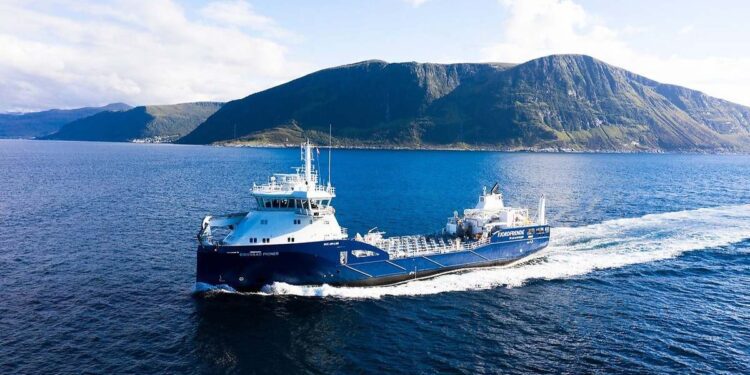Over the past three years, the world’s eyes have been focused on the planet’s largest ‘highway’: the seas. The journey across the oceans sustains the world’s economies, as 80% of global trade is carried out by shipping companies. This reality, which was often taken for granted, has now been threatened first by a powerful supply and logistics crisis in 2021, followed by problems in the Strait of Hormuz, Panama, and Suez. Now, just when it seemed like these issues were more or less resolved, commercial vessels are coming under fire from Houthi rebels in the Red Sea or being captured by countries like Iran, highlighting the geopolitical risks they face on their journeys.
The danger is more real than ever, and both companies and countries are looking for solutions to minimize this damage while improving the efficiency of this channel. Europe is stepping on the gas to make a debate that was present in cars a reality but barely mentioned for the sea: crewless trips. Recently, a tanker successfully arrived on the coast of Norway after completing a 13-hour journey without any crew on board. This journey was a test of the Autoship autonomous model, a EU program to ensure maritime transit.
This milestone has marked a turning point, and although there is still a long way to go, Europe has celebrated it as the certification that a new era in global transportation can be opened in the medium term. Additionally, the old continent could take the lead in what would be a significant advantage. The European Commission itself pointed out that both the Eidsvaag ship (the Norwegian project) and the Zulu Associates ship (the Belgian model) “have demonstrated automated capabilities achieving a fundamental milestone for the adoption of this technology.”
In the case of the Belgian project, also funded by the EU, they are already successfully operating short trips, which would allow for “safer journeys, reduced costs, and greater efficiency,” as explained by Zulu Máss, parent company of the Flemish firm. At the moment, it is not yet safely possible for these vessels to enter the commercial network seamlessly, but the company’s latest statement stated that they expect “with initiatives underway that there will be container ships sailing without crew by 2026.”
From Kongsberg Maritime, the company behind the Eidvaag Pioneer, the Nordic ship that successfully completed the autonomous journey in 2023 stated that “it was an opportunity to show the world that remote and autonomous technologies can be successfully implemented on a general cargo ship, carrying out a variety of operational aspects of a routine trip.” In that sense, the 13-hour demonstration showed how the ship autonomously uncoupled from the port, sailed to its destination, and returned incident-free on a 160 nautical mile trip.
There have been other tests since 2020 when the first models were announced. Japan was the first to conduct them with the Iris Leader, while France launched the VN Rebel and China the Jin Dou Yun. Three ships were tested, although none with as resounding success as the Norwegian one. Tests are also being conducted in the United States, Korea, Finland, and Singapore.
Rolls Royce has been the major company that has most bet on this new disruption. In fact, the president of the company’s maritime division, Mikael Makinen, has expressed that “autonomous navigation is the future of the entire industry” and will be one of the greatest revolutions in the sector. The American company insists that the possibility of applying this technology has been demonstrated since 2017 by its project with the Finnish government. In any case, they believe that by the end of the decade, their first commercial shipment through unmanned ships will reach the market.
For its part, experts at DNV agree that this will be the key project for the entire global logistics sector. “Autonomous maritime transport could offer a way to move to the sea, improving congestion and reducing maintenance costs.” These benefits “have led many governments to consider autonomous concepts, and countries like Finland, Japan, the United States, and Singapore are conducting research and trials.”
However, the firm’s experts believe that there are still key steps that must be taken to ensure that it is safe to charter a vessel without a human on board. “Onboard sensors, machinery for an unmanned vessel, and software must be improved to be safe.” In that sense, they highlight the risk that current attacks on oil tankers can move from shots, drones, or explosives to the digital world and that cargo vessels have to fight a different battle through cybersecurity.
“There are major maritime security challenges with terrorism, piracy, and cyber threats that can turn a ship into a weapon.” Shankar Nishant, a researcher at Next Move Strategy Consulting, explains that AI will be the key reference that can critically accelerate this industry. “This new technology could optimize operations, improve security, and even significantly reduce the chances of error compared to humans.” In that sense, “autonomous ships will generate a large amount of data that can be analyzed to improve efficiency, reduce costs, and enhance security,” something much more complicated with the current model.
World Maritime University is more cautious about its role and arrival, warning that, for this ‘revolution’ to succeed, there is a true legal and technological labyrinth that must be overcome. “The technology has shown that it can be done, which is something completely disruptive for humanity.” However, “there are major maritime security challenges with terrorism, piracy, and cyber threats that can turn a ship into a weapon, a risk that has always been present.” Therefore, for the optimistic announcements to be implemented, “a global strategy and regulations must be developed to overcome these threats.”


